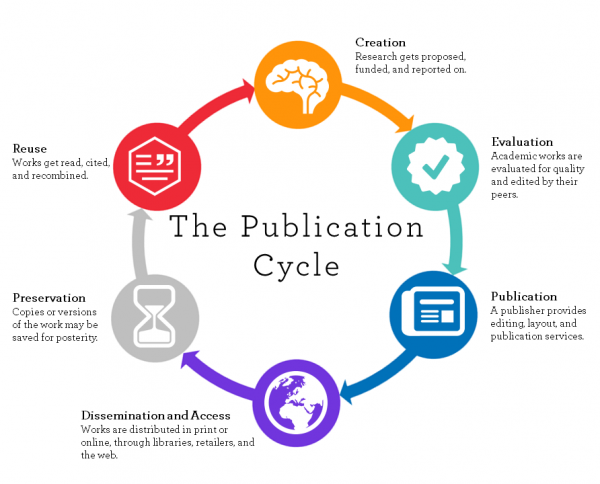Scholarly communication can be thought of as the system through which research and scholarship is created, evaluated, distributed, and preserved. (Association of College & Research Libraries, Principles and Strategies for the Reform of Scholarly Communication 1.)
This system includes traditional or formal publications, such as scholarly journal articles, scholarly chapters or monographs (single-volume books offering research into a specialized area of knowledge), and conference proceedings. It also includes continually emerging publications, such as data sets, data visualizations, working papers, and blogs.
There are many aspects of scholarly publishing -- and many points within the publication lifecycle, from the rudiments of a research idea to a final publication -- at which researchers may need support.
For instance, facilitating the dissemination of scholarly writings means having to consider issues like:
The answers to all of these questions are changing. UC Berkeley’s Office of Scholarly Communication Services (OSCS) assists scholars in navigating this developing field.
With OSCS’ services, the Library aims to support effective, efficient, sustainable, and economically viable systems for the creation, discovery, dissemination, and preservation of scholarship—particularly through systems that provide barrier-free access to quality information.

Scholarly Publication System, courtesy University of Winnipeg
This 25-minute video provides an overview of the process of getting an article published in a peer-reviewed journal, as well as great advice to authors. The video was produced by Taylor & Francis, which is a major UK publishing company.
A 23-minute video and transcript for the video from Dr. Bruce Thompson (Texas A&M University).
"How grad students and junior professors can publish, not perish"
From the Chronicle Vitae, which is associated with The Chronicle of Higher Education.
"How to increase your likelihood of publishing in peer reviewed journals"
By journal editor Hugh McLaughlin via the London School of Economics Blog.
"The really obvious (but all-too-often-ignored) guide to getting published"
Advice from the Chronicle of Higher Education.
"Random reflections on getting published"
Advice from the Chronicle of Higher Education.
Predatory publishers charge exorbitant article processing fees without conducting any editing or peer-review work, often preying on inexperienced or desperate authors. Journals owned by such publishers can either be closed or open access, although the latter is more common.
When you're evaluating a journal- open access or not- to determine if your article is a good fit for the publication, remember to spend some time evaluating the journal/publisher to make sure that the goal of the publication is to share high-quality research which advances scholarship versus solely to make a profit.

Adapted from Canadian Association of Research Libraries.
John B. Coleman Library |
Library Hours
|